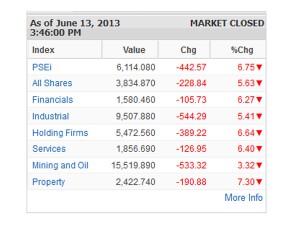MANILA, Philippines—The Bangko Sentral ng Pilipinas has shrugged off concerns over volatility of the country’s financial markets this week, describing the sharp drop in the Philippine Stock Exchange Index (PSEi) as a healthy correction and the depreciation of the peso back to the 43-to-a-dollar level as tolerable.
BSP Deputy Governor Diwa Guinigundo said the decline in the PSEi, which continued to fall in recent days until reaching 6,114.08 on Thursday, should not be a cause for concern as it was just the market’s way of correcting itself after equity prices reached high levels beyond 7,000 earlier this year.
“What we saw was just a healthy correction in the equities market. People were thinking that the price-earnings ratio was becoming high, although there are fundamental basis supporting the expensive equities given the strength of the Philippine economy,” Guinigundo told reporters on Thursday.
The P/E ratio for Philippine equities reached an average of about 22 percent earlier this year, making them among the most expensive in the world.
According to Gunigundo, the BSP at the moment does not see any need to implement measures that will intervene in the way the equities market is behaving.
The BSP has the same opinion on the movement of peso, which has fallen back to the 43-to-a-dollar level since Tuesday on the back of heavy withdrawal of foreign funds, including those invested in peso-denominated stocks.
Guinigundo said the BSP does not need to implement extraordinary measures at this time to temper the peso’s movement.
“The movement of the peso is not unique as other currencies in the [Asian] region also are falling [against the dollar]. The peso’s volatility, in fact, is lower than those of other regional currencies,” Guinigundo said.
He cited data gathered by the BSP showing that the peso’s volatility rate since the start of the year to the morning of June 13 stood at 1.38 percent. He said many other Asian currencies have registered faster volatility rates, citing the 4.62 percent for the Japanese yen.
On Thursday, the peso closed at 43.10 against the US dollar, up by 10 percent from the previous day’s finish of 43.20:$1.
Intraday high hit 43.08:$1, while intraday low settled at 43.32:$1.
Volume of trade amounted to $947.615 million from $1.48 billion the previous day.
The peso appreciation on Thursday only partially recovered the peso’s loss since Tuesday, when it weakened back to the 43-to-a-dollar territory on the back of portfolio fund outflows. Prior to this week, the last time the peso touched the 43:$1 mark was about one year ago.
The peso’s close of 41.05:$1 at the last trading day of 2012 actually made the local currency one of the fastest appreciating currencies against the US dollar throughout 2012.
This was on the back of substantial inflows led by remittances, foreign investments in business process outsourcing sector, and foreign investments in peso-denominated stocks, bonds, and other financial instruments.
But news about an improving US economy, supported partly by increasing number of jobs being created, has caused some fund owners to liquefy some of their investments in emerging markets like the Philippines to be able to buy dollars and dollar-denominated assets.
The BSP, however, believes that the withdrawal of foreign funds is expected to be short-lived.
BSP Governor Amando Tetangco Jr. said the Philippines’ macroeconomic fundamentals remain strong, and generally attractive to foreigners.
“Underlying fundamentals remain sound,” Tetangco said on Thursday in a text message to reporters.
He cited the still benign inflation, which came along a robust pace of economic growth.
The Philippine economy grew by 7.8 percent year on year in the first quarter, the fastest growth rate in Asia for the period and surpassing even China’s 7.7 percent.
Inflation averaged at 3 percent in the first five months of this year, the low end of the government’s target of 3 to 5 percent for this year and 2014.
